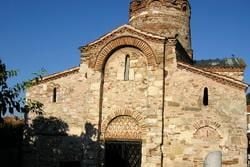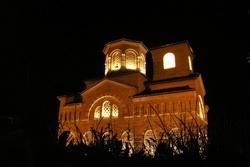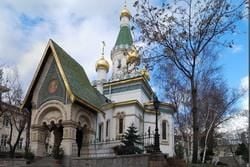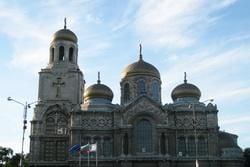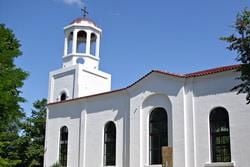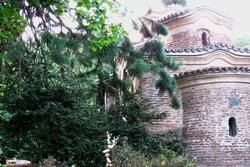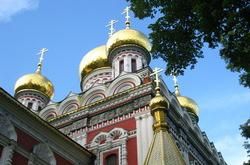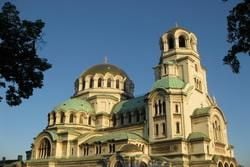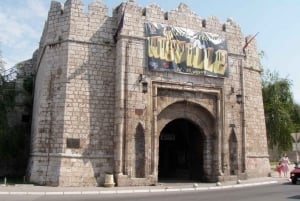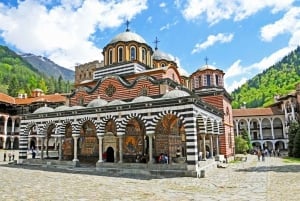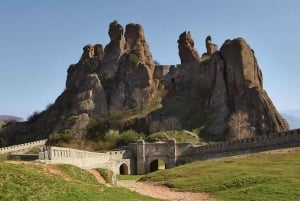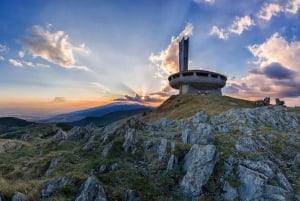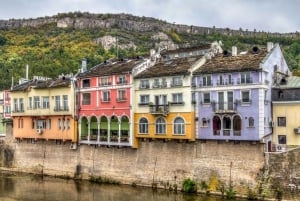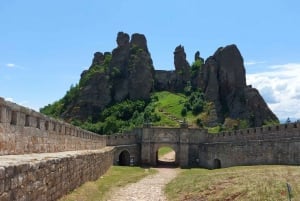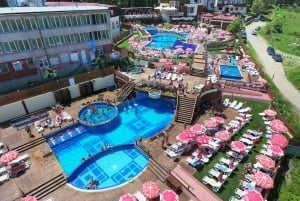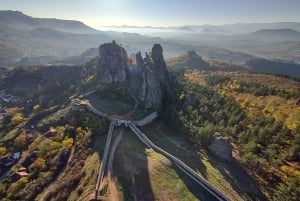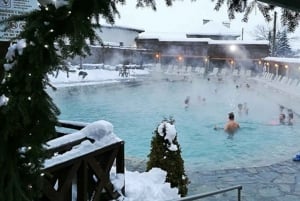Churches in Bulgaria
St. Alexander Nevsky Cathedral:
Alexander Nevsky Church is located in the very heart of
Sofia and has become one of the country’s most precious symbols. It was built at the beginning of the 20th century in honour of the soldiers who lost their lives during the Russo-Turkish War (1877-1878) which led to the liberation of Bulgaria from the Ottoman Empire. But the ties of the church with Russian culture don’t stop here. Both the main architect and the patron of this religious temple were Russians. Designer Alexander Pomerantsev was responsible for the implementation of some of the most ambitious architectural projects in pre-Communist Russia, while St. Alexander Nevsky, the person who the church was named after, was a famous Moscow Prince who lived in the 13th century. Many epithets can be used to describe this building but imposing seems to be the most appropriate one. Indeed, every single aspect of St. Alexander Nevsky Church is enveloped in grandeur. The domes are gold-plated and the facades are clad in Bulgarian stone. The interior is decorated with the finest marble, onyx and alabaster in the world. The murals and the mosaic decorations inside the building were made by renowned Bulgarian and Russian artists. Oh, and its size... It occupies an area of approximately 3100 square metres, its 12-bell church tower rises 53 metres above the ground, and it can take up to 10 000 people inside. One of the most impressive collections of Orthodox art is displayed in the church crypt. It comprises more than 200 icons, frescoes and church plates.
The Hagia Sofia Church of Sofia:
This is the second oldest preserved church in Bulgaria. It was built in the golden age of Byzantine art during the reign of Justinian (527-537). The church walls used to be covered with murals and golden mosaics depicting scenes from the Bible right until the 14th century when the Turks conquered Bulgaria and transformed it into a mosque. Even during the Ottoman Rule, however, its facade remained intact. It was designed as a crossed-dome basilica with a nave and two aisles, a style which was unique for Bulgaria and very illustrative of the classical Byzantine architecture. The grave of Ivan Vazov, the Patriarch of Bulgarian literature, is situated in the eastern end of the church. The church itself lies one minute away from the giant Alexander Nevsky Cathedral.
The Church of St. Nicholas the Wonderworker (the Russian Church):
It is located just a couple of hundred metres away from Alexander Nevsky Church in
Sofia and is one of the most beautiful religious temples in Bulgaria. It was constructed in the period between 1912 and 1914 and carries all the characteristic traits of the typical marquee-shaped Russian churches. In the past it was an important spiritual centre and shelter for the thousands of Russian immigrants who lived in Bulgaria. Today it is one of the most visited attractions in the capital city and the main reason for this is the grave of archbishop Seraphim Sobolev-Wonderworker, hidden in its crypt, which is believed to have miraculous healing powers. The Church of St. Nicholas the Wonderworker is included in UNESCO’s World Heritage List.
Rotunda of St. George the Victorious:
This 1700-year-old red-brick church is the oldest building in
Sofia and also one of the best preserved Roman buildings on the territory of Bulgaria. It was erected by Emperor Constantine as part of an ancient public complex in the 4th century AD and was only discovered by chance 16 centuries later in 1944 when the bombs of the Allied Forces of the Second World War unearthed it. Those who enter the church will witness several layers of wall paintings and ornaments that provide detailed account of the different historical periods the church has gone through. The rotunda is situated in the inner yard of the Bulgarian Presidency, another couple of hundred metres away from the biggest cathedral in the country – Aleksander Nevski.
Boyana Church:
Hiding in the cool forests at the foot of
Vitosha Mountain, south of downtown
Sofia, Boyana Church is one of the most exquisite cultural landmarks not only in Bulgaria but on the entire continent as well. It was set up in the Middle Ages (the 11th century most probably) and today it owns its immense popularity to the fine murals on its walls painted in 1259 by an unknown artist. His innovative approach and revolutionary techniques were considered to be groundbreaking at the time and later his works were described as "several decades ahead" of Giotto’s masterpieces and Italian Renaissance. Thanks to its geographical location and its amazing garden full of venerable trees, this place is commonly regarded as a border between the busy and entertaining big city and the idyllic and tranquil mountain, so it is perfect for all those tourists who wish to get a little break from the noise and emotions of urban life. Boyana Church became one of UNESCO’s World Heritage Sites in 1979.
The Cathedral of the Dormition of the Theotokos:
This is the largest and most emblematic Orthodox cathedral in the city of
Varna. It was also the first Christian monument in the country to commemorate the bravery of the people who fought and died in the name of freedom during the Russo-Turkish War of 1877 and 1878. It officially opened in August 1886 and has been one of the city’s symbols ever since. It went through some significant changes and modifications over the years but the most recent one took place in 2000 when the copper domes were gilded and the façade was renovated. At present the Cathedral of the Dormition of the Theotokos is among the most attractive architectural landmarks of the sea capital of Bulgaria.
The Church of the Holy Forty Martyrs:
The Church of the Holy Forty Martyrs is situated in the town of
Veliko Tarnovo and was founded in the 13th century by Tsar Ivan Asen II, the most successful medieval Bulgarian ruler. Together with Tsarevets Fortress, it is one of the main cultural and architectural tourist attractions of the town. This is so because some of the most remarkable written records of Bulgarian history are kept there, namely the columns of Bulgarian rulers Khan Omurtag (814-831) and Tsar Ivan Asen II (1218-1241). The inscription on Asen’s Column follows the events of the historic victory of the Bulgarian army over Theodore Komnenos, a ruler of Epirus, in the famous battle near the village of Klokotnitsa of 1230 which turned pivotal for the ambitions of the Second Bulgarian State to establish itself as an important political power in Southeastern Europe.
The Russian Church in Shipka (Shipka Monastery):
Not too many people know that the town of Shipka in Central Bulgaria is in fact a tourist destination full of interesting cultural sites. Those who pass by it, however, will find this out momentarily. But how? Well, they simply won’t be able to get their eyes off the golden domes of its magnificent church. The Russian Church in Shipka was built in the period 1885-1902 by Russian architects who dedicated it to all the Ukrainian soldiers who died during the Russo-Turkish Liberation War of 1877-1878. Its design is typically Russian: the façade is painted in deep blue and red colours, the imposing 17-bell bell tower rises 53 m above the ground and the interior frescoes tend to depict generally optimistic religious scenes and saints. The monks who live in the monastery complex surrounding the church are friendly and willing to help tourists, which is yet another thing that makes the trip to this Orthodox temple a worthwhile experience. The monastery yard is a perfect relaxation and recuperation spot.
St. Cyril and St. Methodius Church:
Situated in the historical district of the coastal town of
Sozopol, 35 km south of
Burgas, this 19th-century temple is neither the oldest, nor the most architecturally impressive in the country. What makes it so special though is much more important than plain figures and good looks. It keeps the relics of John the Baptist which were discovered in 2010 during excavations on the nearby Island of St. Ivan. Every year thousands of people visit the church to witness this miraculous archaeological finding with their own eyes.
The Churches of Nesebar:
The town of
Nesebar is located in the southeastern part of the
Black Sea Coast, between the big urban centres Burgas and Varna. It has the reputation of one of the most preferred summer destinations in the country and rightly so: it’s got sandy beaches, nice hotels, cafes, restaurants, night clubs and…an Old Town. This is the real treasure of Nesebar. It is home to myriads of historical and cultural landmarks, including 40 of the most spectacular churches in Bulgaria. They all vary in shape, origin and condition. The most famous ones are the basilica of the Holy Theotokos Eleusa (6th century), the three-naved basilica of St. Sofia (4th century), the medieval Orthodox Church of Christ Pantocrator (13th century), the Church of St. Stephen (10th century), the Church of the Holy Archangels Michael and Gabriel (13th century), etc. In 1983 Old Nesebar was included in the List of World Cultural and Natural Heritage Sites of UNESCO.


